
Bouldering is a form of free climbing that is performed on small rock formations or artificial rock walls without the use of ropes or harnesses. While bouldering can be done without any equipment, most climbers use climbing shoes to help secure footholds, chalk to keep their hands dry and to provide a firmer grip, and bouldering mats to prevent injuries from falls. Unlike free solo climbing, which is also performed without ropes, bouldering problems are usually less than six metres (20 ft) tall. Traverses, which are a form of boulder problem, require the climber to climb horizontally from one end to another. Artificial climbing walls allow boulderers to climb indoors in areas without natural boulders. In addition, bouldering competitions take place in both indoor and outdoor settings.
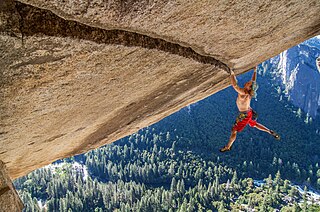
Climbing is the activity of using one's hands, feet, or other parts of the body to ascend a steep topographical object that can range from the world's tallest mountains to small boulders. Climbing is done for locomotion, sporting recreation, for competition, and is also done in trades that rely on ascension, such as rescue and military operations. Climbing is done indoors and outdoors, on natural surfaces, and on artificial surfaces

Many climbing routes have a grade that reflects the technical difficulty—and in some cases the risks and commitment level—of the route. The first ascensionist can suggest a grade, but it will be amended to reflect the consensus view of subsequent ascents. While many countries with a strong tradition of climbing developed grading systems, a small number of grading systems have become internationally dominant for each type of climbing, which has contributed to the standardization of grades worldwide. Over the years, grades have consistently risen in all forms of climbing, helped by improvements in climbing technique and equipment.

Glossary of climbing terms relates to rock climbing, mountaineering, and to ice climbing.

Ice climbing is a climbing discipline that involves ascending routes consisting of frozen water. To ascend the route, the ice climber uses specialist equipment, particularly double ice axes and rigid crampons. To protect the route, the ice climber uses steel ice screws that require skill to employ safely and rely on the ice holding firm in any fall. Ice climbing routes can vary significantly by type, and include seasonally frozen waterfalls, high permanently frozen alpine couloirs, and large hanging icicles.

Solo climbing, or soloing, is a style of climbing in which the climber climbs a route alone, without the assistance of a belayer. By its very nature, it presents a higher degree of risk to the climber, and in some cases, is considered extremely high risk. Note that the use of the term "solo climbing" is generally separate from the action of bouldering, which is itself a form of solo climbing, but with less serious consequences in the case of a fall. The most dangerous form of solo climbing is free solo climbing, which means both climbing alone and without any form of climbing protection.
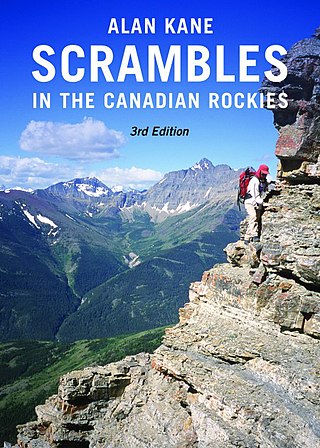
Climbing guidebooks are used by mountaineers, alpinists, ice climbers, and rock climbers to locate, grade, and navigate climbing routes on mountains, climbing crags, or bouldering areas. Modern route guidebooks include detailed information on each climbing route, including topo diagrams, route beta, protection requirements, and the ethics and style that are in place for a given climbing area.
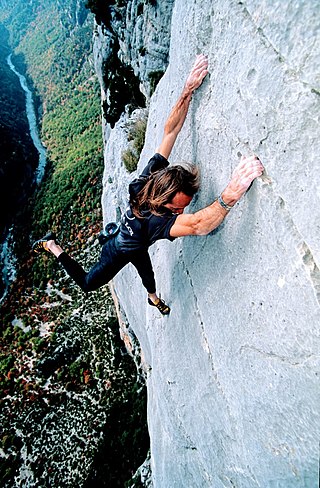
Free solo climbing, or free soloing, is a form of rock climbing where the climbers climb solo without ropes or other protective equipment, using only their climbing shoes and their climbing chalk. Free soloing is the most dangerous form of climbing, and, unlike bouldering, free soloists climb above safe heights, where a fall can be fatal. Though many climbers have free soloed climbing grades they are very comfortable on, only a tiny group free solo regularly, and at grades closer to the limit of their abilities.

The Regular Northwest Face of Half Dome was the first Grade VI big wall climbing route in the United States. It was first climbed in 1957 by a team consisting of Royal Robbins, Mike Sherrick, and Jerry Gallwas. Its current aid climbing rating is VI 5.9 A1 or 5.12 for the free climbing variation. It is recognized in the historic climbing text Fifty Classic Climbs of North America and considered a classic around the world.
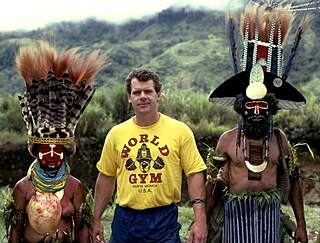
John Long is an American rock climber and author. His stories have been translated into many languages.

Pat Ament is an American rock climber, filmmaker, musician, and artist who lives in Fruita, Colorado. Noted for first ascents in the 1960s and 1970s, he is the author of many articles and books.

Jim Holloway, an American, was one of the first of a new generation of boulderers for whom the sport was a lifestyle rather than a recreation. He began bouldering in the early 1970s in Boulder, Colorado, and in 1973 established his first notable route, Just Right. In 1975 he put up Trice – at today's grade of V12 (8A+), now considered the first-ever at that grade in bouldering history.
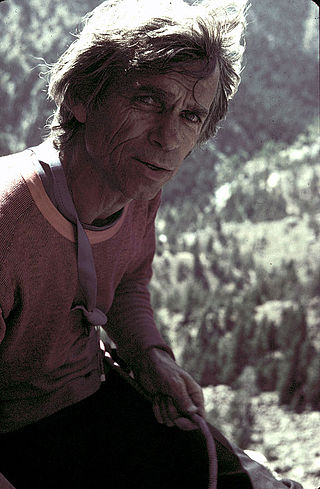
Bob Kamps was an American rock climber whose climbing career spanned five decades. Born in Wisconsin, he began climbing in California in 1955, and was a member of that cadre of Yosemite pioneers who first ascended many of its great walls in the 1950s and 1960s. He was particularly adept on steep rock faces, and was among the first to shift attention from aid climbing to free climbing. Over the years he made more than 3,100 climbs. Many were first ascents or first free ascents.

In the history of rock climbing, the three main sub-disciplines—bouldering, single-pitch climbing, and big wall climbing—can trace their origins to late 19th-century Europe. Bouldering started in Fontainebleau, and was advanced by Pierre Allain in the 1930s, and John Gill in the 1950s. Big wall climbing started in the Dolomites, and was spread across the Alps in the 1930s by climbers such as Emilio Comici and Riccardo Cassin, and in the 1950s by Walter Bonatti, before reaching Yosemite where it was led in the 1950s to 1970s by climbers such as Royal Robbins. Single-pitch climbing started pre-1900 in both the Lake District and in Saxony, and by the late-1970s had spread widely with climbers such as Ron Fawcett (Britain), Bernd Arnold (Germany), Patrick Berhault (France), Ron Kauk and John Bachar (USA).

Big wall climbing is a form of rock climbing that takes place on long multi-pitch routes that normally require a full day, if not several days, to ascend. In addition, big wall routes are typically sustained and exposed, where the climbers remain suspended from the rock face, even sleeping hanging from the face, with limited options to sit down or escape unless they abseil back down the whole route. It is therefore a physically and mentally demanding form of climbing.
Mark Wilford is an American rock climber and alpinist known for his bold, traditional style.

Mixed climbing is a climbing discipline used on routes that do have not enough ice to be pure ice climbs, but are also not dry enough to be pure rock climbs. To ascend the route, the mixed climber uses ice climbing tools, but to protect the route, they use traditional or sport rock climbing tools. Mixed climbing can vary from routes with sections of thick layers of ice and sections of bare rock to routes that are mainly bare rock but which is “iced-up”.

Thomas "Tom" M. Frost was an American rock climber known for big wall climbing first ascents in Yosemite Valley. He was also a photographer and climbing equipment manufacturer. Frost was born in Hollywood, California, and died in Oakdale, California.

In climbing and mountaineering, a traverse is a section of a climbing route where the climber moves laterally, as opposed to in an upward direction. The term has broad application, and its use can range from describing a brief section of lateral movement on a pitch of a climbing route, to large multi-pitch climbing routes that almost entirely consist of lateral movement such as girdle traverses that span the entire rock face of a crag, to mountain traverses that span entire ridges connecting chains of mountain peaks.

Alpine climbing is a type of mountaineering that involves using any of a broad range of advanced climbing skills, including rock climbing, ice climbing, and/or mixed climbing, to summit typically large routes in an alpine environment. While alpine climbing began in the European Alps, it is used to refer to climbing in any remote mountainous area, including in the Himalayas and in Patagonia. The derived term alpine style refers to the fashion of alpine climbing to be in small lightly-equipped teams who carry all of their own equipment, and do all of the climbing.





















